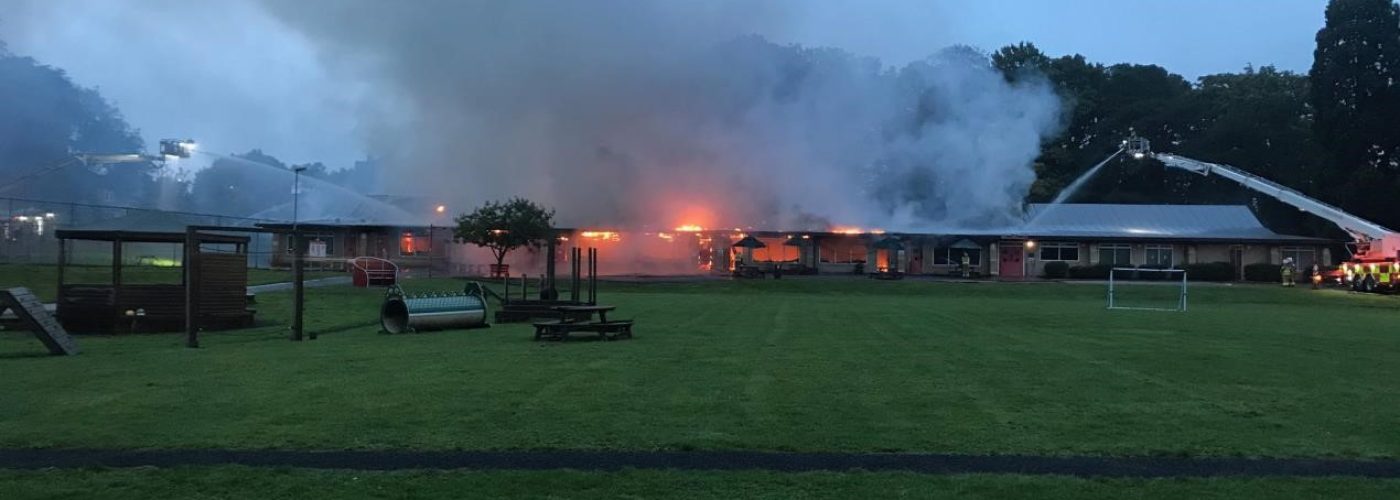The upheaval in education due to the pandemic in the past year has only highlighted how damaging the closure of schools has been and the legacy of lost learning. Further unnecessary interruption to education should be avoided, not least when it comes to fire. With hundreds of schools in the UK having a fire each year It needs further action. During the past year we have seen major fires in schools across the UK all without sprinklers that could have minimised those incidents. As we enter the NFCC Sprinkler Week, fewer than one-in-six new schools have been built with a sprinkler system installed. It is time we changed that.
School fires have a devastating impact on both a school and a community. Three school fires in Derbyshire last year are a painful reminder of the damage, disruption and the costs incurred when they are not fitted with sprinklers.
On the morning of Saturday 3rd October, six fire engines and two aerial ladder platforms were called to attend a major blaze at St Mary’s Catholic Voluntary Academy in Darley Abbey, Derby. The fire quickly engulfed the building, which was largely destroyed and reported as a ‘total loss’. Just 48 hours later, in the early hours of Monday 5th October, there was a second severe fire only four miles away, this time at Ravensdale Infant School in Mickleover which required 12 fire engines from the Derbyshire Fire and Rescue Service. Whilst the Fire and Rescue service brought the fire under control there was extensive damage to the building. Neither building had sprinklers fitted.
The children from the St Mary’s Catholic Voluntary Academy were originally sent to work from home for three weeks before being displaced into two separate local schools. They have now been reunited in temporary accommodation within a refurbished office block over three floors. There is no firm date for the replacement school. The children from the Ravensdale school are being moved to temporary locations and may move again during the £8 million rebuild of their schools which is expected to be completed late in 2022.
These two devastating fires come in the wake of a blaze in the same area four months earlier at Harrington Junior School in Long Eaton, Derbyshire. Thankfully, no children were on site and teachers and staff who were working in the building were able to evacuate safely. Despite the efforts of the Fire and Rescue Service, they were unable to save the building. Not only did the fire severely affect the children’s education when they returned to temporary classroom accommodation after lockdown, the school will have to be rebuilt. The temporary classroom accommodation was noted to cost £500,000 and is expected to be in place for two years during the rebuild. The cost of the rebuild was further reported to be £5.5 million and will require central funding.
Currently, sprinklers are currently only mandatory in new school buildings in Scotland and centrally funded schools in Wales, but not in England and Northern Ireland. Yet observations on the incidence of fire relative to the population of school buildings, indicate that the rate of fires in England is the same as in Scotland and Wales.
According to a 2019 study by Zurich Municipal1, education insurer for half of the schools and universities in the UK, two-thirds of schools have ‘poor’ fire protection and are not properly prepared for a potential damaging fire. It also found that schools in England are ‘twice as likely’ to suffer fires than other school buildings. The insurer has stated that a change to government legislation to make sprinklers mandatory will not only protect children in school, but will also contain a fire to the room it starts when it begins out of school hours.
The government is still considering the response to its call for evidence on Building Bulletin 100 (BB100) which closed in May 2019. The BSA has always highlighted that BB100 sets the right expectations around the protection of schools and the continuity of education. It sets an expectation that the school should be fully functional within 24 hours of a fire, apart from the room where the fire occurred. The BSA wants the government to explicitly maintain these objectives and enhance the “sprinkler expectation” in the revised BB100 so that fewer schools are damaged and destroyed by fire. Better still, the government should make property protection a consideration for the fire safety Building Regulations to effectively protect all buildings of significant social and/or economic value from fire.
Ensuring the safety of a building’s occupants is considered the minimum under current regulations, but it is clearly not the optimal outcome. A sprinkler system would serve to protect both the occupants and the building, allowing students to return to normality far more rapidly and with considerably less disruption to teachers’ already hectic schedules during this pandemic.
Fires in schools must be avoided. How many more fires need to occur before sprinkler installation becomes a prerequisite of school design and safety?
1Schools twice as likely as other buildings to be hit by a blaze






